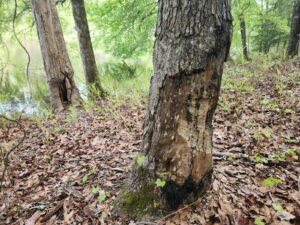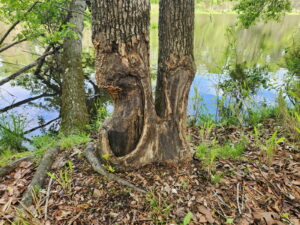Beaver Damage
go.ncsu.edu/readext?1069258
en Español / em Português
El inglés es el idioma de control de esta página. En la medida en que haya algún conflicto entre la traducción al inglés y la traducción, el inglés prevalece.
Al hacer clic en el enlace de traducción se activa un servicio de traducción gratuito para convertir la página al español. Al igual que con cualquier traducción por Internet, la conversión no es sensible al contexto y puede que no traduzca el texto en su significado original. NC State Extension no garantiza la exactitud del texto traducido. Por favor, tenga en cuenta que algunas aplicaciones y/o servicios pueden no funcionar como se espera cuando se traducen.
Português
Inglês é o idioma de controle desta página. Na medida que haja algum conflito entre o texto original em Inglês e a tradução, o Inglês prevalece.
Ao clicar no link de tradução, um serviço gratuito de tradução será ativado para converter a página para o Português. Como em qualquer tradução pela internet, a conversão não é sensivel ao contexto e pode não ocorrer a tradução para o significado orginal. O serviço de Extensão da Carolina do Norte (NC State Extension) não garante a exatidão do texto traduzido. Por favor, observe que algumas funções ou serviços podem não funcionar como esperado após a tradução.
English
English is the controlling language of this page. To the extent there is any conflict between the English text and the translation, English controls.
Clicking on the translation link activates a free translation service to convert the page to Spanish. As with any Internet translation, the conversion is not context-sensitive and may not translate the text to its original meaning. NC State Extension does not guarantee the accuracy of the translated text. Please note that some applications and/or services may not function as expected when translated.
Collapse ▲Most people are unaware that we have a healthy population of beavers in Union County. Beavers are native to Union County, and their population across North Carolina is on the rise. They are beneficial to the ecosystem by creating wetland habitats, which are increasingly rare as most wetlands have been lost to land-use change (development, agriculture, etc.). However, beavers can also be destructive by causing unwanted flooding.
Another way beavers can be destructive is by damaging high-value trees in yards that abut ponds, lakes, creeks, or rivers. Beavers are herbivores, and their diet primarily consists of leaves, woody stems, and aquatic plants. They also eat the inner bark of trees, known as cambium, which is highly nutritious. Beavers have continuously growing teeth, and they need to chew on wood to keep them from growing too long and sharp. This chewing also helps to wear down the teeth, keeping them at a manageable size for eating and other activities. And felling entire trees grants them access to the canopy of the tree, so they can eat the leaves and smaller woody stems.
If you have valuable urban trees/yard trees near a body of water, even a smaller creek, you might consider protecting them from beavers by wrapping the trunks in a cage made of metal wire 3-4 feet in height. The cage needs to be securely anchored to the ground, as they are good diggers and may attempt to dig under the cage. Beavers can chew through chicken wire, so choose a sturdier wire fencing product.

The tree in the foreground shows fresh beaver damage, while the tree in the background shows very old beaver damage
This website offers advice on metal wire cages and alternatives, including a mixture of paint and sand. They also encourage you to plant alternative food sources for the beavers, such as stakes of willow, cottonwood, and dogwood that naturally occur in low wet areas and help stabilize creek banks. Project Beaver






